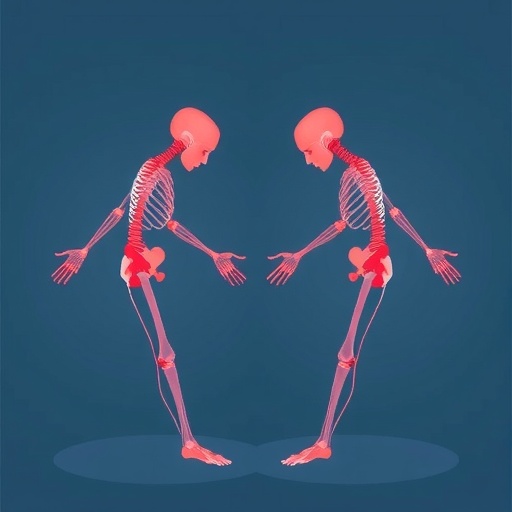In the landscape of neurodegenerative diseases, Parkinson’s disease (PD) stands as a formidable challenge to both clinicians and patients, with its multifaceted manifestations extending far beyond the well-characterized motor symptoms. A recent systematic review by Voruz, Guérin, and Péron, published in the renowned journal npj Parkinson’s Disease, casts new light on the intricate relationship between motor symptom asymmetry and the often overlooked non-motor outcomes in Parkinson’s disease. This comprehensive synthesis not only deepens scientific understanding but also opens avenues for more personalized approaches to managing this complex disorder.
Parkinson’s disease is widely recognized for its cardinal motor symptoms—tremor, bradykinesia, rigidity, and postural instability. One distinctive hallmark frequently noted in clinical practice is the asymmetrical onset and progression of these motor symptoms. Typically, patients exhibit more pronounced motor impairment on one side of the body, a phenomenon that manifests due to the unilateral degeneration of dopaminergic neurons in the substantia nigra pars compacta. However, the implications of this lateralization have historically been confined to motor function analysis, leaving a significant gap in the exploration of non-motor symptoms, which profoundly affect patient quality of life.
Non-motor symptoms in Parkinson’s disease encompass a wide range of physiological and psychological disturbances, including cognitive impairments, mood disorders, autonomic dysfunction, sleep disturbances, and sensory anomalies. These symptoms are increasingly recognized as critical determinants of disease burden. Voruz et al.’s systematic review pioneers an integrative approach by examining how the asymmetrical expression of motor symptoms correlates with the severity, presentation, and progression of non-motor manifestations. This linkage suggests a paradigm shift in viewing Parkinson’s disease not as a uniform neurodegenerative process but rather as a highly individualized condition with symptom clusters influenced by neural lateralization.
.adsslot_sNandRtZAO{ width:728px !important; height:90px !important; }
@media (max-width:1199px) { .adsslot_sNandRtZAO{ width:468px !important; height:60px !important; } }
@media (max-width:767px) { .adsslot_sNandRtZAO{ width:320px !important; height:50px !important; } }
ADVERTISEMENT
The review meticulously gathered data from multiple clinical trials and observational studies, synthesizing evidence that implicates the dominant hemisphere affected in PD patients as a significant factor in neuropsychological outcomes. For instance, patients with predominant right-sided motor symptoms often demonstrate distinct cognitive profiles compared to those with left-side dominance. This phenomenon can be attributed to the specialization of cerebral hemispheres—where the left hemisphere generally governs language and analytical processes, and the right hemisphere is more involved with visuospatial and emotional processing. The asymmetric neurodegeneration triggers differential non-motor symptomatology depending on which hemisphere is primarily impacted.
One of the core findings highlighted is the correlation between motor asymmetry and mood disorders, particularly depression and anxiety, conditions that burden Parkinson’s patients with significant morbidity. The review posits that asymmetry related to left-hemisphere dopaminergic loss correlates more strongly with depressive symptoms, possibly due to the left hemisphere’s role in positive affect and mood regulation through frontal-limbic networks. This nuanced understanding challenges previous assumptions that attributed mood disturbances in PD solely to diffuse neurochemical deficits and underscores the critical role of lateralized brain pathology.
Cognitive decline, ranging from mild cognitive impairment to Parkinson’s disease dementia, also exhibits distinctions linked to motor symptom asymmetry. Patients with right-sided motor symptom predominance tend to experience earlier deficits in visuospatial abilities and executive function compared to those with left-sided dominance. This is consistent with neuroanatomical models, as the right hemisphere significantly contributes to spatial awareness and executive cognitive processes. Thus, the side of motor function predominance is an essential factor influencing the cognitive trajectories in Parkinson’s disease, with practical implications for neuropsychological assessment and intervention.
Sleep disorders, including REM sleep behavior disorder (RBD), excessive daytime sleepiness, and insomnia, affect a substantial portion of Parkinson’s patients and significantly degrade life quality. Voruz and colleagues synthesize emerging evidence suggesting that patients with certain asymmetric motor symptom profiles may exhibit different vulnerabilities to sleep disturbances. This relationship offers a fertile ground for future studies aimed at dissecting the neural circuitries underpinning sleep-wake regulation in the context of PD’s lateralized neurodegeneration.
The review also touches upon sensory symptoms such as hyposmia (reduced sense of smell) and pain perception, identifying asymmetry-related trends that could inform clinical evaluation and symptom management. The pathophysiological mechanisms underlying these observations remain elusive, but they represent an important frontier in understanding PD’s heterogeneity. A deeper grasp of sensory symptom asymmetry holds promise not only for enhanced diagnostic precision but also for unveiling novel therapeutic targets.
Methodologically, the paper stands out for its rigorous inclusion criteria and synthesis techniques, incorporating neuroimaging studies, detailed neuropsychological batteries, and longitudinal cohorts. This multifaceted approach enables a robust analysis of the asymmetric impact on non-motor symptoms, transcending simple cross-sectional correlations. Importantly, it proposes a refined framework for future research that integrally considers asymmetry as a critical variable in Parkinson’s disease pathophysiology and clinical phenotype characterization.
From a therapeutic standpoint, the implications of this review are profound. Recognizing the influence of motor symptom asymmetry on non-motor symptom profiles could revolutionize personalized medicine in Parkinson’s disease. Tailored interventions—pharmacological, cognitive-behavioral, and rehabilitative—might be designed with greater regard to the patient’s dominant side of symptomatology, potentially enhancing efficacy and minimizing side effects. Furthermore, this perspective encourages clinicians to adopt a more nuanced assessment strategy that encompasses lateralized symptom analysis as part of routine care.
The review by Voruz et al. also opens up discussion about the underlying neurobiological mechanisms driving lateralized degeneration and symptom expression. It is hypothesized that genetic, epigenetic, and environmental factors may predispose certain neural circuits to asymmetric vulnerability. Additionally, compensatory neuroplasticity and interhemispheric communication dynamics might modulate symptom expression, raising fascinating questions for future exploration in both human and animal models.
Importantly, this study underscores the need for interdisciplinary collaboration across neurology, neuropsychology, neuroimaging, and rehabilitation sciences to unravel the complexities of Parkinson’s disease’s heterogeneity. Emerging technologies such as advanced neuroimaging modalities, machine learning-based pattern recognition, and wearable sensor arrays offer powerful tools to capture and analyze asymmetric symptom progression in real time, complementing traditional clinical assessments.
In conclusion, the seminal work of Voruz, Guérin, and Péron significantly advances our understanding of Parkinson’s disease by illuminating how motor symptom asymmetry intricately influences the spectrum of non-motor outcomes. By recontextualizing lateralization as a central factor in PD’s clinical heterogeneity, this review paves the way for precision medicine approaches that promise to improve diagnosis, prognostication, and patient-centered care.
As the Parkinson’s research community embraces these insights, the ultimate beneficiaries will be the millions of patients navigating the unpredictable terrain of this multifactorial disease. Future clinical trials and longitudinal studies incorporating motor symptom asymmetry as a key variable are poised to unlock tailored therapeutic strategies, ultimately mitigating the profound non-motor burdens that have long challenged effective management of Parkinson’s disease.
Subject of Research: Impact of motor symptom asymmetry on non-motor outcomes in Parkinson’s disease
Article Title: Impact of motor symptom asymmetry on non-motor outcomes in Parkinson’s disease: a systematic review
Article References:
Voruz, P., Guérin, D. & Péron, J.A. Impact of motor symptom asymmetry on non-motor outcomes in Parkinson’s disease: a systematic review. npj Parkinsons Dis. 11, 188 (2025). https://doi.org/10.1038/s41531-025-01046-4
Image Credits: AI Generated
Tags: cognitive impairments in Parkinson’simpact of motor symptoms on non-motor outcomesmotor asymmetry in Parkinson’s diseaseneurodegenerative disease managementParkinson’s disease non-motor symptomsParkinson’s disease quality of lifepersonalized treatment for Parkinson’spsychological effects of Parkinson’s diseaserelationship between motor and non-motor symptomssystematic review of Parkinson’s diseaseunilateral motor symptom progression





